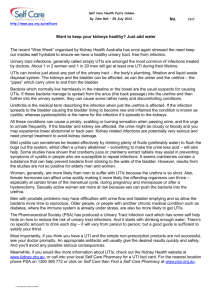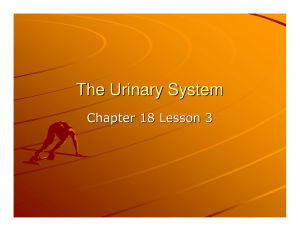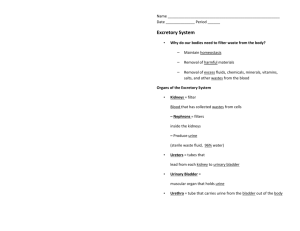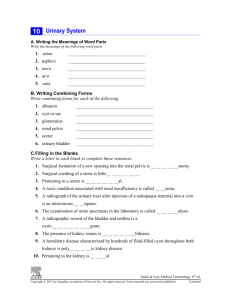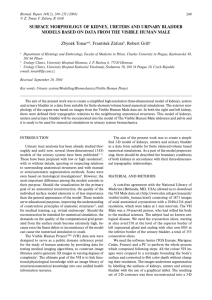Unit 5 Urinary System
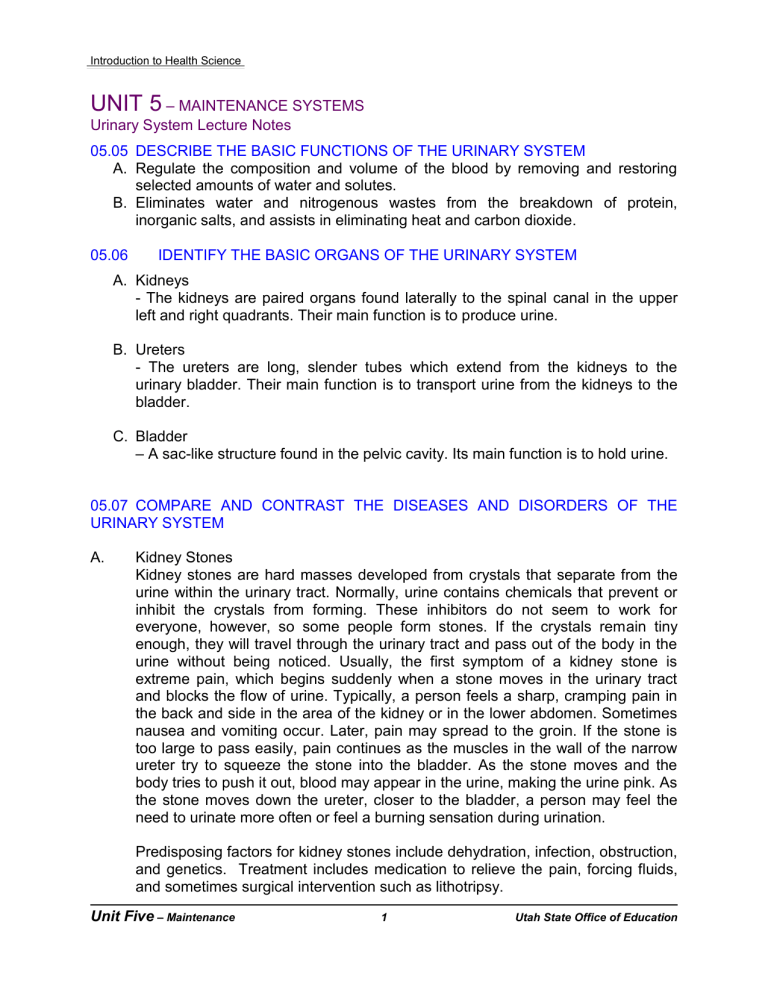
Introduction to Health Science
UNIT 5
– MAINTENANCE SYSTEMS
Urinary System Lecture Notes
05.05 DESCRIBE THE BASIC FUNCTIONS OF THE URINARY SYSTEM
A. Regulate the composition and volume of the blood by removing and restoring selected amounts of water and solutes.
B. Eliminates water and nitrogenous wastes from the breakdown of protein, inorganic salts, and assists in eliminating heat and carbon dioxide.
05.06 IDENTIFY THE BASIC ORGANS OF THE URINARY SYSTEM
A. Kidneys
- The kidneys are paired organs found laterally to the spinal canal in the upper left and right quadrants. Their main function is to produce urine.
B. Ureters
- The ureters are long, slender tubes which extend from the kidneys to the urinary bladder. Their main function is to transport urine from the kidneys to the bladder.
C. Bladder
– A sac-like structure found in the pelvic cavity. Its main function is to hold urine.
05.07 COMPARE AND CONTRAST THE DISEASES AND DISORDERS OF THE
URINARY SYSTEM
A. Kidney Stones
Kidney stones are hard masses developed from crystals that separate from the urine within the urinary tract. Normally, urine contains chemicals that prevent or inhibit the crystals from forming. These inhibitors do not seem to work for everyone, however, so some people form stones. If the crystals remain tiny enough, they will travel through the urinary tract and pass out of the body in the urine without being noticed. Usually, the first symptom of a kidney stone is extreme pain, which begins suddenly when a stone moves in the urinary tract and blocks the flow of urine. Typically, a person feels a sharp, cramping pain in the back and side in the area of the kidney or in the lower abdomen. Sometimes nausea and vomiting occur. Later, pain may spread to the groin. If the stone is too large to pass easily, pain continues as the muscles in the wall of the narrow ureter try to squeeze the stone into the bladder. As the stone moves and the body tries to push it out, blood may appear in the urine, making the urine pink. As the stone moves down the ureter, closer to the bladder, a person may feel the need to urinate more often or feel a burning sensation during urination.
Predisposing factors for kidney stones include dehydration, infection, obstruction, and genetics. Treatment includes medication to relieve the pain, forcing fluids, and sometimes surgical intervention such as lithotripsy.
Unit Five – Maintenance 1 Utah State Office of Education
Introduction to Health Science
B. Kidney Failure
Kidney failure is the loss of the kidney ’s ability to perform their main function — eliminate excess fluid and waste material from the blood. When the kidneys lose their filtering ability, dangerous levels of fluid and waste accumulate in the body.
Signs and symptoms include decreased urine output, fluid retention, drowsiness, shortness of breath, fatigue, confusion, seizures or coma in severe cases.
Treatment includes a modified diet, IV fluids, and dialysis until kidney function returns to normal.
C. Bladder Infection
Bladder infections are known as cystitis or inflammation of the bladder. They are common in women but very rare in men. More than half of all women get at least one bladder infection at some time in their lives. However, a man's chance of getting cystitis increases as he ages due to in part to an increase in prostate size.
Bladder infections are not serious if treated right away. But they tend to come back in some people. Rarely, this can lead to kidney infections, which are more serious and may result in permanent kidney damage. So it's very important to treat the underlying causes of a bladder infection and to take preventive steps to keep them from coming back.
Unit Five – Maintenance 2 Utah State Office of Education




